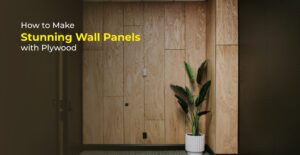

You walk into a room and your eyes immediately lock onto the stunning beauty of the floor beneath your feet. Smooth, seamless plywood panels greet you with warmth and elegance, transforming the space into a haven of comfort and style. Installing plywood flooring isn’t just about covering up the ground – it’s about creating a canvas for your creativity to flourish and a foundation for your dreams to take shape. So, grab your hammer and tape measure, because today we’re delving into the tips for installing plywood flooring like never before.
Take the time to plan out your plywood layout before diving into the installation process. Measure your space carefully and determine the best orientation for your plywood sheets to minimise waste and achieve a visually pleasing aesthetic. Consider the location of doorways, cabinets and other obstacles when laying out your flooring plan.
It’s crucial to select the right plywood. Opt for high-quality plywood with a minimum thickness of 12mm for durability and stability. Additionally, consider the grade of the plywood – look for sheets with minimal voids and a smooth, sanded surface for a flawless finish.
A solid foundation is key to a successful plywood flooring installation. Ensure your subfloor is clean, flat and dry before laying down any plywood sheets. Use a levelling compound to fill in any gaps or imperfections and make sure to remove any protruding nails or debris that could affect the integrity of your flooring.
Allow your plywood sheets to acclimatise to the environment of your space for at least 72 hours before installation. This helps prevent warping or buckling once the flooring is in place. Stack the plywood sheets horizontally with spacers between each sheet to promote proper air circulation.
When securing your plywood sheets to the subfloor, opt for the appropriate fasteners to ensure a secure and long-lasting installation. Use galvanised screws or nails designed specifically for plywood flooring, spaced at regular intervals along the perimeter and within the field of each sheet.
Leave a small gap, typically around 1/8 inch, between plywood sheets to accommodate for expansion and contraction due to changes in temperature and humidity. Use spacers or shims to maintain consistent spacing throughout the installation process, and be sure to fill these gaps with a flexible sealant once the flooring is in place.
Pay special attention to securing the edges of your plywood sheets to prevent them from lifting or shifting over time. Use construction adhesive along the perimeter of each sheet before fastening them to the subfloor and be sure to stagger the joints between adjacent rows for added stability.
Once your plywood flooring is installed, take the time to sand down any rough edges or imperfections to create a smooth and uniform surface. Then, apply a high-quality sealant or finish to protect the plywood from moisture, stains and wear. Consider multiple coats for added durability and longevity. Sweep or vacuum regularly to remove dirt and debris, and clean up spills promptly to prevent staining.
Congratulations! You’ve successfully installed plywood flooring like a pro! But the journey doesn’t end there. To keep your plywood flooring looking its best for years to come, be sure to implement a regular maintenance routine.
And there you have it—the top 8 tips for installing plywood. With a little patience, attention to detail and the right tools and techniques, you’ll be well on your way to achieving the perfect plywood flooring for your space. So, roll up your sleeves and get to work! Happy flooring!











